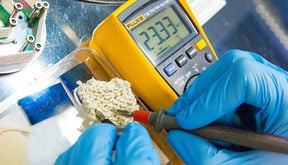Special journal issue showcases Aalto University’s materials research

Advanced Electronic Materials, an academic peer-reviewed high-impact materials science journal, has published a special issue dedicated to materials research at Aalto University.
The 12 articles of the special issue investigate materials and devices that are being researched for their applications in micro-electronics, opto-electronics, thermo-electricity generation, photovoltaics and quantum technologies. The contributors include 40 Aalto University researchers and 10 external researchers.
In one of the featured articles, Assistant Professor Antti Karttunen and his collaborators studied ways to combine electronic materials with cotton, the most widely used natural fiber. Such thermoelectric materials in textiles can be used to convert waste body heat to electric energy.
The researchers fabricated flexible, thermoelectric zinc oxide thin films as nano-scale layers on a cotton textile using atomic layer deposition (ALD). The ALD technique offers a highly controllable way to deposit semiconducting inorganic materials on yarns and textiles. The zinc oxide–organic thin films were – to the researchers’ knowledge – the first inorganic-organic hybrid material that can be fabricated directly on a flexible substrate, showing thermo-electric properties. The research represents a step towards flexible thermoelectrics that can be integrated into textiles for wearable electronics.
Another featured article by Dr. Oliver T. Hofmann and Professor Patrick Rinke is also devoted to novel organic-inorganic hybrid systems. The two researchers show how band bending at the interface between an inorganic, transparent conductive oxide and organic semiconductors can be controlled. Band-bending often has averse effects and the results indicate that the full toolbox of organic chemistry can be used to design surface-modifications that lead to a desired amount of band-bending or completely suppress it. The results contribute to the development of organic electronic devices with better long-term stability and performance.
The special issue of Advanced Electronic Materials highlights Aalto University’s expertise in cutting-edge materials science research globally. Publications in materials science at Aalto University are cited 55 percent more often than the world average. 18 percent of the publications belong to the most cited 10 percent in the world.
In 2016, Aalto University established the Materials Platform to initiate and coordinate multi- and interdisciplinary research and teaching in materials science. In the Platform, around 100 professors collaborate on different aspects of materials science. The annual budget of materials related research at Aalto is 75 million euros, from which one third comes from external sources.
Article: Advanced Electronic Materials, Special Issue: Materials Platform at Aalto University, DOI: 10.1002/aelm.201770023
More information:
Professor Patrick Rinke, [email protected]
Materials Platform Manager Kati Miettunen, [email protected]
http://materialsplatform.aalto.fi/en/
LIST OF THE ARTICLES IN ADVANCED ELECTRONIC MATERIALS, SPECIAL ISSUE 06/2017:
Elimination of Lateral Resistance and Current Crowding in Large-Area LEDs by Composition Grading and Diffusion-Driven Charge Transport - Pyry Kivisaari, Iurii Kim, Sami Suihkonen, and Jani Oksanen
Progress Reports:
Engineering the Electronic Properties of Two-Dimensional Transition Metal Dichalcogenides by Introducing Mirror Twin Boundaries - Hannu-Pekka Komsa and Arkady V. Krasheninnikov
Defects in Single Crystalline Ammonothermal Gallium Nitride - Sami Suihkonen,* Siddha Pimputkar, Sakari Sintonen, and Filip Tuomisto
Full papers:
Ozone-Based Atomic Layer Deposition of Al2O3 from Dimethylaluminum Chloride and Its Impact on Silicon Surface Passivation - Yameng Bao,* Mikko Laitinen, Timo Sajavaara, and Hele Savin
Band Bending Engineering at Organic/Inorganic Interfaces Using Organic Self-Assembled Monolayers - Oliver T. Hofmann* and Patrick Rinke
Flexible Thermoelectric ZnO–Organic Superlattices on Cotton Textile Substrates by ALD/MLD - Antti J. Karttunen,* Liisa Sarnes, Riikka Townsend, Jussi Mikkonen, and Maarit Karppinen
On the Monte Carlo Description of Hot Carrier Effects and Device Characteristics of III-N LEDs - Pyry Kivisaari, Toufik Sadi, Jingrui Li, Patrick Rinke, and Jani Oksanen*
Microwave Admittance of Gold-Palladium Nanowires with Proximity-Induced Superconductivity - Russell E. Lake,* Joonas Govenius, Roope Kokkoniemi, Kuan Yen Tan, Matti Partanen, Pauli Virtanen, and Mikko Möttönen
Electronic Quality Improvement of Highly Defective Quasi- Mono Silicon Material by Phosphorus Diffusion Gettering - Zhengjun Liu, Ville Vähänissi, Hannu S. Laine, Morten Lindeberg, Marko Yli-Koski, and Hele Savin*
First-Principles Modeling of Point Defects and Complexes in Thin-Film Solar-Cell Absorber CuInSe2 - Maria Malitckaya, Hannu-Pekka Komsa, Ville Havu, and Martti J. Puska*
Engineering Efficient p-Type TMD/Metal Contacts Using Fluorographene as a Buffer Layer - Tiziana Musso,* Priyank V. Kumar, Jeffrey C. Grossman, and Adam S. Foster
Enhanced p-Type Transparent Semiconducting Characteristics for ALD-Grown Mg-Substituted CuCrO2 Thin Films - Tripurari S. Tripathi and Maarit Karppinen*
- Published:
- Updated:
Read more news

Unite!’s Open Science and Innovation Management Handbook now available online and in print
The handbook is a practical guide for university researchers, R&I support services, and university managers.New covers, writing templates and ordering system for doctoral theses
The current doctoral thesis ordering system will be replaced after 30 Nov 2024. New covers and writing templates have been designed for doctoral theses.
What makes nature restorative? Aalto University researchers explore Finnish forests and Japanese gardens
Biodiversity is central to the restorative power of Finnish forests.